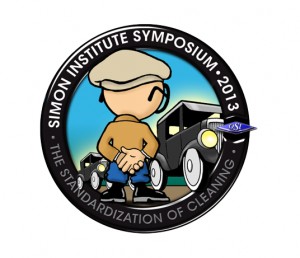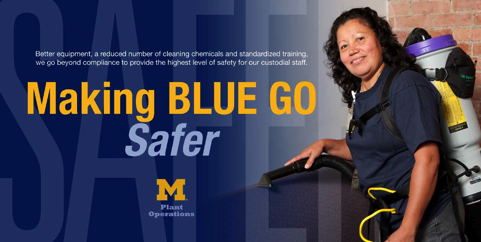Tag Archive for: (OS1)
Improve Restroom Cleaning Productivity
/in Blog/by lisaArticle written for Facility Cleaning Solutions by Ben Walker, ManageMen, Inc.
To improve productivity, set up pantries near or in the restroom, which can be used to safely store consumables. This greatly reduces the amount of paper that workers have to keep on their carts, and minimizes time spent traveling back and forth to restock….
CLICK HERE to read full article.
Read all about it: The Cleaning Gazette – November 2013 Issue now available
/in Blog/by lisaClick on the link below to read the November 2013 issue of The Cleaning Gazette. The Cleaning Gazette is the official publication of the Cleaning Industry Trainer’s Guild.
Simon Institute joins ANSI, initiates SDO process
/in Blog/by lisa The education facilities industry is on track to manage about one-third of the total cost of ownership of its facilities with the entry of one of its major supplier advocates into the American national standards process. The Simon Institute (SI) — the non-profit choice for the custodial, janitorial and housekeeping
The education facilities industry is on track to manage about one-third of the total cost of ownership of its facilities with the entry of one of its major supplier advocates into the American national standards process. The Simon Institute (SI) — the non-profit choice for the custodial, janitorial and housekeeping
industry in the US — recently became a member of the American National Standards Institute during World Standards Week in Washington D.C. October 22-23, 2013.
World Standards Week is an annual gathering of US standards developers from all business sectors of the US economy to develop policy and strategy for adapting to the changing world economies by hastening innovation through technical standards development. From this process a national standard for custodial services in
the education industry will emerge from a consensus process that will make a leading practice document suitable for adoption into public law. The word “consensus” is important since it represents a common viewpoint of those parties concerned with its provisions, namely producers, users, consumers and general interest groups
On November 1st SI initiated the process to become a registered standards developing organization (SDO). SDO’s provide the following benefits for any industry, in any country:
- SDOs provide a forum for collective decision-making and an alternative to standardization through market competition or government regulation.
- SDOs identify promising solutions and play an important role in promoting their adoption and diffusion.
- SDOs support lower prices offered by producers who are able to realize economies of scale in a global market.
- SDOs provide the technical means by which political trade agreements are put in place when divergent national or regional standards create technical barriers to trade.
- SDO’s level the playing field for building industry suppliers and service providers so that resources are available from multiple sources.
- SDO’s provide public safety benchmarks for front line enforcement authorities.
The entry of the Simon Institute into the ANSI process follows the trajectory of a 16-year University of Michigan-led national strategy to manage infrastructure costs of the $300 billion US education facilities industry through the American national standards process. Of this $300 billion — which includes large university-affiliated hospitals — about $75 billion is spent on cleaning — 90 percent of that cost; labor.
The objective of this is to put in place a permanent and enduring structure for continual leading practice development that will net TCO by $3 billion to $6 billion per year in an environment of rising risk,
complexity and regulatory conformity cost. In the long run, this process always results in more effective use of money, management of worker risk, and a hygienically safer built environment.
There is a subtle reciprocity between innovation and standardization. Standards stimulate the innovation of products, services and systems just as innovation drives the need for standardization. In some cases, a standard fosters innovation by establishing a baseline for design and performance that will satisfy user requirements.
The Simon Institute is the continuation of an organization founded in 2002 by The Boeing Company to identify, benchmark and incorporate best practices in facility custodial operations. The driving force of the original meeting was The Boeing Company’s initiative to qualify for the Malcolm Baldrige Quality Award. Several world class organizations, all users of ManageMen’s Operating System One (OS1), were invited to meet with Boeing at the largest building in the world, the Everett Washington Boeing plant, to share or debate best practices in janitorial operations. At the conclusion of the symposium the group decided to continue meeting annually in a joint project to develop improved industry standards.
A well-conceived standard provides flexibility that suppliers or manufacturers can vary features, function, or price to establish their own niche in the marketplace. These variances can help to elevate user expectations of a product or service, thus raising the bar for future editions of the applicable standard. In other markets and technologies, innovation comes first. A single set of performance or design criteria are agreed upon and serve as the baseline for ongoing improvements.
A standard becomes the physical documentation of an agreed-upon solution that has already been time-tested and proven.
The next steps are as follows:
1. Public announcement of Simon Institute ANSI membership (this announcement)
2. Development of By-Laws and Consensus procedure
3. Establish technical committees
4. Write the standard
5. Release for first public review
6. Revise in response to public comments and re-post for 2nd public review
7. Revise in response to public comments in 2nd public review
8. Formally adopt the standard and announce its release in the ANSI Standards Action publication that is made available weekly to the public.
9. Promote adoption and support with conformity and accreditation programs.
Depending upon the process preferred by the Simon Institute, the foregoing process may be modified.
The most surprising standard of all may not ever be written but may always lie in the public eye. Our industry is engaged in policy initiatives that require us to confront the cost of value-delivery that is very expensive relative to available resources. All levels of government are under pressure to use intergovernmental collaboration to spread the cost of managing educational facilities across wider tax bases; capitalizing economies of scale or economies of skill inherent in some services. Our industry must hasten its effort to write its own rules, or we will have them written for us.
Now Accepting: Nominations for Outstanding Cleaning Worker of the Year Award
/in Blog/by lisa
[fbshare type=”button” float=”left”]
[linkedin_share style=”none” float=”left”]
[twitter style=”horizontal” float=”left”]
To nominate an Outstanding Cleaning Worker from your organization, please click here.
The time is fast approaching when we will be recognizing outstanding cleaning workers. Approximately two-and-a-half million people earn their living in the U.S. as janitors, custodians and housekeepers. Most toil through their shift, day after day with little notice of their contribution to the orderly operation of every business.
In 2009, The SIMON INSTITUTE decided to honor outstanding cleaning workers during the Simon Institute Symposium each year. They commissioned a beautiful medal to be designed for the occasion. George Dansie and Shu Yamamoto (ManageMen’s Cartoonist), created a special medal that is a work of art to honor the best of our best cleaners.

John Walker, ManageMen, Inc., presents an Outstanding Cleaning Worker Award at the 2011 (OS1) Users Symposium.
At the symposium in Deerborn, Michigan this year, we will honor the Outstanding Cleaning Workers in America for the fifth year in a row. Now is the time for your organization to fill out the application form for the recipient your organization wants to recognize. Organizations are invited to honor more than one medal recipient.
Medals will be presented during the Cleaning Industry Awards Banquet, Monday, July 15 at the Dearborn Inn – A Marriott Hotel. Cleaning workers who attend the banquet will be presented the award in a special medal ceremony following the Pinnacle Award for Lifetime Achievement.
The cleaning worker’s “bio” will be read to the group, their photo will be displayed on the screen and Renae and John Walker of ManageMen will present the awards.
Among the criteria for selection employees must display a commitment to professional pride and care; be self motivated and accountable; demonstrate a positive; conscientious and considerate attitude toward customers, fellow employees and others; provide continual outstanding performance of any kind within the campus of facilities that build and support the assembly process; and excellence in the performance of job duties.
If you are unable to send outstanding cleaning worker’s that you wish to honor in your organization, you may conduct your own medal ceremony at your location. Many organizations are large, with hundreds, even thousands of cleaning workers, the SIMON INSTITUTE decided not to limit the number of medals for which an organization may apply.
2013 Symposium Location Announced
/in Blog/by lisa
[linkedin_share style=”none” float=”left”]
[fblike style=”standard” float=”left” showfaces=”false” width=”450″ verb=”recommend” font=”arial”]
[twitter style=”horizontal” float=”left”]
The Simon Institute is pleased to announce that the location has been set for the 2013 Simon Institute Symposium. The Symposium will take place in historic Dearborn, Michigan. Dearborn is home to historic spots like the Henry Ford Museum and the nearby Rouge River Auto Plant. The Simon Institute felt that this would be the perfect site to pay homage to standardized processes and improving benchmarks. Representatives from the University of Michigan and Michigan State University have graciously agreed to assist the Simon Institute in hosting this event in their home state.
The Simon Institute Symposium will take place July 15-17, 2013. Registration is now open and can be completed by clicking here. Special rateds are available for lodging at The Dearborn Inn. Be sure to mention that you will be attending the Simon Institute Symposium to secure special rates. For more details about this event, please visit www.simoninstitute.org
Dedication and Quality Training Leads to Recognizable Improvements at LAHH
/in Blog/by lisa[fbshare type=”button” float=”left”]
[linkedin_share style=”none” float=”left”]
[twitter style=”horizontal” float=”left”]
Submitted by Nancy Albin
LAHH

The LAHH Christmas Bowling Party 2012. In front, Daniel and Bryan – Light Duty Specialists in the certification program.
“What we’re doing is recognizable”, said Mike during the LAHH supervisor meeting. Mike manages a team of six custodial specialists of which four are people with special needs. Jamie, on Mike’s team, has started to show improvement with managing the Super Coach BackPac Vacuum, even though her hand-eye coordination and equilibrium are impacted by her disability. But it is clear her heart is not! Mike told us he is so proud of her as she has been working hard to learn the specialty and not give up.
Mike also shared that Jamie has been improving and how her work is recognizable. And this is what he loves about (OS1) and working as a utility specialist. Guido went on to say, “Mike, you are right. When we look back at our finished work we can see a change, we can see something different from before. We are improving something.” Guido shared that during the last certification class, the homework focused on cleaning plays for Light Duty Specialist and in question #2, asked what should be picked up from the floor prior to the Vacuum Specialist arriving to the area? Mike responded that Jamie hasn’t had to pick up anything too large for the vacuum or call back a Light Duty specialist. The Light Duty Specialists on Mike’s team are also in the certification program. Quality in education extends to quality in the workplace. What is happening in the classroom at the LAHH (OS1) training facility is recognizable . . . in the workplace.
University of Michigan Saves $2.1 Million Per Year and Improves Cleaning
/in Blog/by lisa[linkedin_share style=”none” float=”left”]
[fbshare type=”button” float=”left”]
[twitter style=”horizontal” float=”left”]
Submitted by ProTeam
CGN Editorial

The ProTeam Super CoachVac was featured in a series of posters at University of Michigan to educate the community about the elements of the new cleaning program.
In 2009, the University of Michigan in Ann Arbor started a five year rollout of a comprehensive, high-performance cleaning management system, ManageMen‘s Operating System 1®, (OS1). John Lawter, Associate Director of Plant Building and Ground Services, chose (OS1) to improve productivity in light of ongoing budget cuts.
“We knew we were facing multiple years of reductions so we offered up 10% over 5 years with an understanding we would have a couple of years reprieve to protect our new program.” said Lawter. And since implementing (OS1), “We have met that 10 percent goal of $2.1 million and managed to improve services at the same time.”
With 200 facilities to clean covering a total of 15 million sq. ft., Lawter’s staff has gone from cleaning 36,000 sq. ft. per custodian to 40,000 sq. ft. per custodian, while improving the health of the environment. One of the biggest tenets of (OS1) is to clean for health first, then appearance. It was this and the simplified workflow that appealed to Lawter who wanted more consistency and fewer products.
“(OS1) was the only operating system we could find that was comprehensive and had been tested in a University setting for better than 10 years,” said Lawter. “We visited those programs as part of our due diligence and were impressed.”
In (OS1), custodians specialize in specific tasks, and they do all tasks of a single function at one time. This reduces wasted time switching tools and backtracking. Vacuum specialists may vacuum for an entire shift using a backpack vacuum designed by ProTeam® to reduce strain to the user.
“Dr. Berry’s study at the University of North Carolina showed us that, used properly, the backpack vacuum was a more ergonomic and effective product than an upright,” said Lawter.
Lawter swapped a ramshackle collection of uprights of different ages and models for ProTeam’s 11-pound Super CoachVac®.
“There’s no beater bar to throw dust around,” said Lawter. “It reduces the amount of dust particles in the air.” Two of Lawter’s staff who suffered from allergies reported their symptoms noticeably improving after switching to the backpack vacuum. ProTeam is partnered with the American Lung Association in efforts to educate the public about the importance of healthy indoor air.
Prior to implementing (OS1), the biggest problem Lawter faced was inconsistent performance, a symptom of the zone cleaning system they were using previously.
“No two custodians clean exactly alike,” said Lawter. “So, when one custodian is responsible for everything in an area, there will naturally be differences in the level of service. Our customers noticed those inconsistencies.”
According to Jeffrey L. Campbell, Ph.D., Chair of the BYU Facility Management program, Most custodial operations: “1) have no quantifiable standards; 2) are based solely on appearance; 3) have little or no method of measuring effectiveness and performance; 4) are not based on actual research; and 5) are driven by chemical and equipment manufacturers.”
Campbell recorded the story of the University of Michigan’s cleaning success along with the University of North Carolina and two other universities that implemented (OS1) in the article “Cutting Costs and Improving Outcomes for Janitorial Services” which appeared in the September/October 2011 issue of Facilities Manager and was reprinted in the Cleaning Gazette Newsletter the following May.
“In an industry that has been around as long as public buildings themselves, janitorial methods have seen little progress. As a matter of fact, most janitors today use the same tools and processes that were used 50 years ago,” said Campbell.
In addition to the timesaving backpack vacuums, (OS1) reduced Lawter’s chemical inventory from 50 products to less than 10. Individual use portion packs ensure that custodians get what they need and only what they need to clean every day. For Lawter, this hugely simplified the process.
“We used to have a committee of 30 people that would meet once a month and review the latest and greatest new products that came down the line,” said Lawter. “It was very inefficient, time-consuming, expensive, and led to a proliferation of products out there being tested by our workforce. ManageMen has a research and development arm for (OS1) users that does that, so I don’t directly deal with salesman. I love that.”
John Walker, President of ManageMen and progenitor of (OS1), explains how the echo chamber of product claims in the cleaning industry is rarely substantiated by science. “Everyone sells productivity tools. People buy them to save money and time, but they never document that they did it,” said Walker. “The University of Michigan’s janitorial department is a pioneer in documenting over $2 million in savings. They gave it back to the university.”
As reported in the Cleaning Gazette Newsletter last July, Sightlines, a prominent facility management assistance firm, did a thorough evaluation of the University of Michigan in the fall of 2010. They compared the data to a database of 300 institutions of higher learning and a group of 10 peer universities chosen by the administration.
This survey was taken in the midst of the (OS1) rollout at the university. The custodial department had not yet reached the 80-percent audit they hoped for. They were still rated as the number one organization in cleanliness evaluations. The study also showed high production rates and low cost of materials in comparison to their peers and the greater database.
“They got to a 2.5 cleaning level on a 3.5 APPA budget,” said Walker. “And in the Sightlines study, they beat virtually everyone in the country and in their peer group after adopting (OS1). There has never been a collection of data like this.”
In their most recent (OS1) audit last month, the University of Michigan surpassed their goal of an 80 percent audit, reaching 83 and 87 percent. According to Walker, it is the work of people like Lawter and his staff in documenting the effectiveness of (OS1) that will someday take the cleaning industry by storm. When cleaning is standardized, workflows are simplified, and productive tools are utilized, unbelievable savings are possible. “You can reduce costs and improve results with this documented system,” said Walker.
